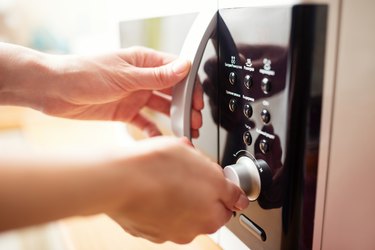
From college dorms to workplaces to family kitchens, microwaves are the workhorse of the modern American kitchen. Some reports suggest 97 percent of American kitchens now have a microwave.
But, when it comes to what's cooking, size counts with microwaves. Larger microwaves have greater power output, which means getting the job done faster and sometimes better. This is measured in wattage.
Video of the Day
Video of the Day
When determining the size of a microwave, you'll need to consider the inside, outside and wattage.
It's What's Inside the Counts
The internal measurements of a microwave are stated in cubic feet. To determine cubic feet, one should multiply the microwave's interior length by width by height, then divide this total by 1,728. So, a microwave that is 18 by 14 by 12 inches is 1.75 cubic feet in size.
Microwaves vary from 0.6 cubic feet to over 2 cubic feet, with the average size sold being 1.4 to 1.8 cubic feet.
Size Classes for Microwaves
There are four size categories for microwaves, based on internal capacity, which will help you narrow down what to look for in a new microwave.
A compact microwave is any that's under 1 cubic foot. A midsize microwave ranges between 1 to 1.5 cubic feet. A full size is between 1.6 to 2 cubic feet, and anything larger than 2 cubic feet is considered extra large.
Yes, the Outside Counts, Too
The inside size is very important with microwaves, especially with turntables that rotate so the entire item cooks properly, but the outside counts, too.
Whether you have an ever-shrinking urban space or a big family, the size of the whole microwave unit matters. A microwave can't teeter off the edge of a counter or you'll face spillage and improper heating issues. Properly measure the space that will house your microwave, and take a measuring tape with you when buying a unit to ensure it'll fit.
In general, compact models start at around 10 by 18 by 14 inches and go up to around 14 by 24 by 20 inches for larger sizes.
Styles of Microwave
There are three offerings when it comes to size classes for microwaves – built-in, countertop, and over-the-range.
A built-in can vary in size, from small to large, but it saves space by usually being wall-mounted or attached below a cabinet, helping to make a small space more efficient.
Countertop microwaves are by far the most common and flexible of microwaves, ranging from tiny ones perfect for a dormitory room or a small office, up to large ones dominating a corner of your kitchen. Countertop microwaves make installation a nonissue and are often more budget-friendly to purchase.
Over-the-range microwaves have grown in popularity. They tend to be among the largest microwaves and can be terrific for a family. Their raised position, though, can make it unsafe for children to access. Often, they have a built-in light under them to provide illumination for your stove top and possibly a fan to absorb range-top cooking odors.
Watts Up, Chef?
Microwaves are available from 500 watts up to 1,200 watts. Wattage makes a huge difference in efficiency and cooking time. Consider, over a year, the difference in microwaving a single cup of water. A 600-watt microwave would take over three minutes versus two minutes in a 1,000-watt microwave, and shorter still for a more powerful unit.
A microwave of 1,000 to 1,200 watts will easily handle the kinds of meals required for families and busy kitchens.
Beyond Size
For much of the microwave's existence, size, aesthetics and wattage were all things to consider in a purchase. Today, though, microwaves offer a variety of features and abilities, from convection cookery to LED interior lighting.
Still, when you're looking into microwaves, size remains critical inside and out. So, when you're looking for a new unit, know what meals and jobs you need your microwave to do, research accordingly, and then you can look for the bells and whistles that work for you.